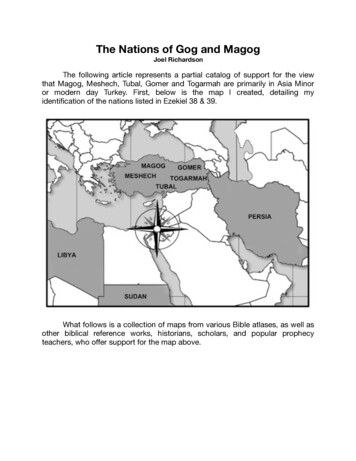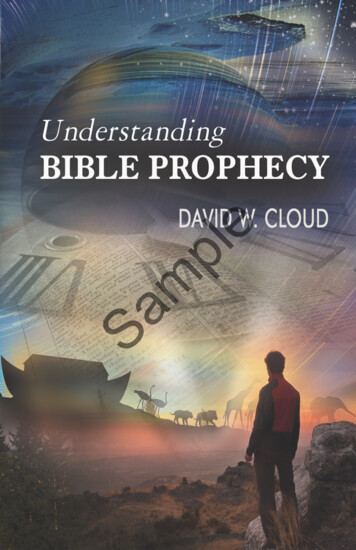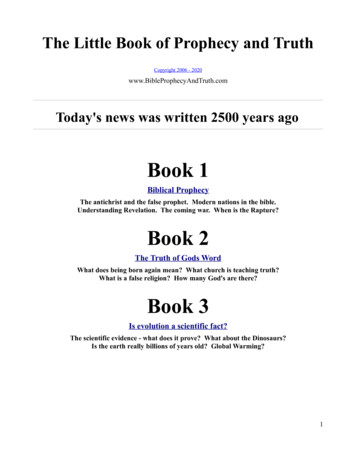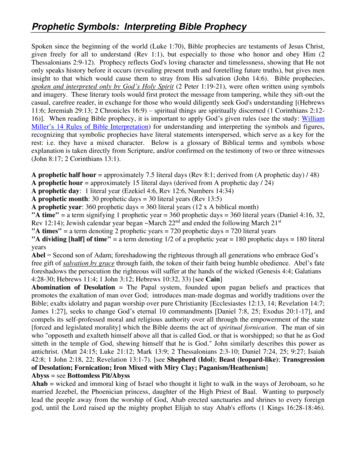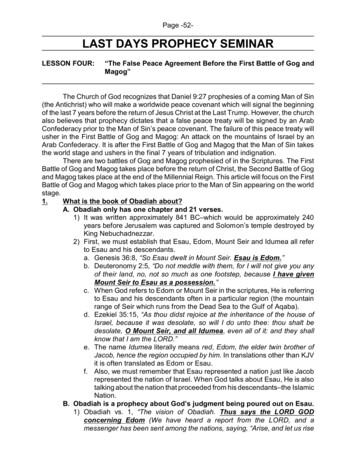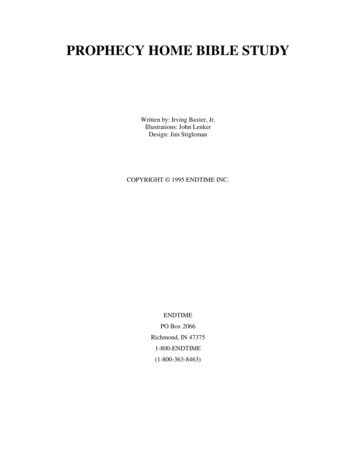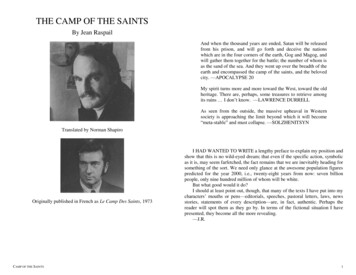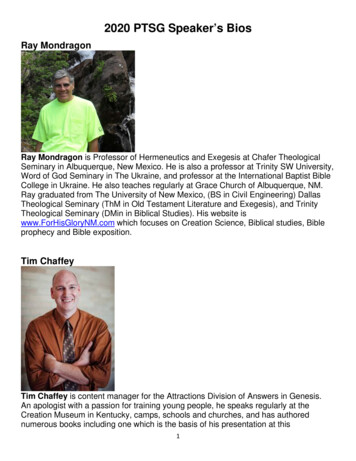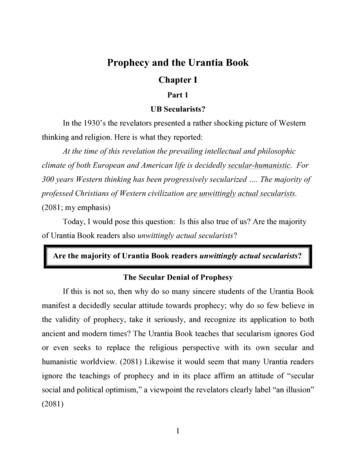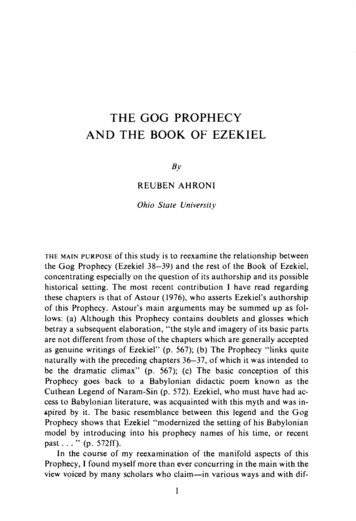
Transcription
THE GOG PROPHECYAND THE BOOK OF EZEKIELByREUBEN AHRONIOhio State Universityof this study is to reexamine the relationship betweenthe Gog Prophecy (Ezekiel 38-39) and the rest of the Book of Ezekiel,concentrating especially on the question of its authorship and its possiblehistorical setting. The most recent contribution I have read regardingthese chapters is that of Astour ( 1976), who asserts Ezekiel's authorshipof this Prophecy. Astour's main arguments may be summed up as follows: (a) Although this Prophecy contains doublets and glosses whichbetray a subsequent elaboration, "the style and imagery of its basic partsare not different from those of the chapters which are generally acceptedas genuine writings of Ezekiel" (p. 567); (b) The Prophecy "links quitenaturally with the preceding chapters 36-37, of which it was intended tobe the dramatic climax" (p. 567); (c) The basic conception of thisProphecy goes back to a Babylonian didactic poem known as theCuthean Legend of Naram-Sin (p. 572). Ezekiel, who must have had access to Babylonian literature, was acquainted with this myth and was inspired by it. The basic resemblance between this legend and the GogProphecy shows that Ezekiel "modernized the setting of his Babylonianmodel by introducing into his prophecy names of his time, or recentpast . " (p. 572ff).In the course of my reexamination of the manifold aspects of thisProphecy, I found myself more than ever concurring in the main with theview voiced by many scholars who claim-in various ways and with difTHE MAIN PURPOSE
2REUBEN AHRONIferent shifts of emphasis (see below)-that the Gog Prophecy is an independent and self-contained entity which differs widely from the rest ofthe Book of Ezekiel in content, form, mood and literary genre. ThisProphecy is not only alien to the style and train of thought of Ezekiel, butalso clearly interrupts the sequence and consistent chronological schemeof chs. 1-37 and 40-48. The Prophecy has its setting in a late, post-exilicperiod and is therefore a later intrusion in the Book of Ezekiel. The purpose of this study is to substantiate this view by focusing on the literaryaspects and on the mood and outlook of the Prophecy.Before approaching this issue, I feel that two limitations should beimposed on this study: one concerns the unity of the Book of Ezekiel, andthe other the unity of the Gog Prophecy itself.The Unity of the BookThe first two decades of this century witnessed a radical shift in the attitude of biblical scholars toward the unity and authorship of the Book ofEzekiel-from a traditional and strictly conservative approach toward acritical approach. A detailed survey of the diverse critical attitudestoward this Book is beyond the scope of this study. 1 However, in order toclarify and emphasize the main points of my position a few relevantremarks seem to be in order.In 1880 Smend (pp. XXlff) was so impressed by what he thought tobe the homogeneity, consistency, systematic arrangement and logical sequence of the Book, that he concluded the whole Book of Ezekiel mighthave been written "in einem Zuge", and that not a single section may beremoved without destroying the whole ensemble. This became the dominant view in biblical scholarship and was maintained, inter alias, byDriver (1913, p. 279), who posited that "no critical question arises in connection with the authorship of the book, the whole from beginning to endbearing unmistakably the stamp of a single mind."This long standing traditional picture of the Book has been radicallychallenged by later scholars who seriously questioned the unity of theBook, its authorship, and the authenticity of its prophecies. The firstI. For a thorough and Iucid survey of this literature, cf. Greenberg ( 1970, pp. XlXXIX); Irwin (1943, pp. 3-30; 1965, pp. 139-174).
THE GOG PROPHECY3thoroughgoing, critical attack on the genuineness of the Book of Ezekielwas launched by Holscher (1924, p. 39) who recognized less than 170 outof a total of 1,273 verses in the entire book as a genuine core which he attributed to the prophet Ezekiel. All the rest (the prose portions and theprophecies of restoration) he attributed to later redactors of the fifth century B.C.E., who incorporated their work into the original Ezekelianpoetic oracles of doom, and gave the Book the systematic structure whichit now has. 2 This radical shift of attitude among biblical scholars foundcogent expression in Torrey's words (1939, p. 78): "It is as though abomb had been exploded in the Book of Ezekiel, scattering the fragmentsin all directions. One scholar gathers them up and arranges them in oneway, another makes a different combination." 3It can be seen, therefore, that with regard to the Book of Ezekiel thependulum of biblical scholarship has swung from one extreme to theother. Although it is true that the problem of Ezekiel is still a controversial issue today, it seems that except for some shifts of emphasis and a fewdivergences, biblical scholarship at the present has widely departed fromboth extreme positions. Current scholarship is fluctuating around a basicconservative approach, which adheres to the substantial accuracy of thetraditional view of Ezekiel. True, most recent scholars agree that someportions of the text of the Book are in an extremely bad state, disfiguredby corruptions and therefore badly confused; many of the words andphrases are unintelligible; and the text suffers from contradictions,doublets, dislocations, misplacement of passages, glosses and elaborations by later hands. In spite of all these, recent scholars tend to acceptthe book's own assertions about the time and place of the prophet'sproclamations: "The major studies which have appeared since 1950 .suggest a more conventional picture, and the present period is witnessinga return to something like the position before 1930" (Stalker, 1968, p.18). Generally speaking, such is the basic approach of-among others2. Twenty years later Irwin (1943) recognized only 251 genuine verses in whole or inpart within the first 39 chapters of the Book (chapters 40-48 were ascribed to a laterauthor). Thus Irwin considered more than eighty percent of the Book to be secondary,forming as he thought a later commentary, or even commentary upon commentary (cf.May, 1956, pp. 44-45).3. Torrey himself greatly contributed to the shattering of the traditional views, when hecharacterized the Book of Ezekiel as a pseudepigraphon purporting to come from the reignof Manasseh, but in fact composed in the third century B.C.E. and converted by an editornot many years after the original work had appeared-into a prophecy of the BabylonianGolab (Torrey, 1930 and 1934).
4REUBEN AHRONIEichrodt (1970) 4 as well as that of Fohrer (1955), Zimmerli (from 1955onward), 5 and Howie (1950 and l 962a,b ).Except for the Gog Prophecy this study will, therefore, adhere to themodified traditional view, i.e. that although the Book of Ezekiel does notbear the stamp of a single mind, as Driver posited ( 1913, p. 279), it doesbear at least the spirit and the train of thought of Ezekiel.The Unity of the Gog ProphecyThe unity of the Gog Prophecy itself was also challenged by manyscholars. The apparent contradictions, obscurities, and incongruitieswhich appear in the Prophecy have led many scholars to assume it to becomposite in nature. Bertholet (l 936, pp. l30ff) sought to solve these difficulties, and the apparent lack of a logical sequence of thought, by assuming two parallel recensions which had been conflated by an editorand amplified by later hands. 6 Eichrodt ( 1970, p. 52 l) failed to find in thisprophecy any dramatic unity of conception and he asserted that it isnothing but "a series of individual visions, impossible to combine withone another into an organic picture . " The most radical and thoroughattack on the unity of this prophecy was launched by Irwin (l 943, pp.172 ff), who considered the whole Prophecy to be spurious, concedingauthenticity only to the introductory formula and to ten additionalwords, which he considered to be the genuine oracle of Ezekiel. Irwinmaintains that the original oracle comprises a single tristich line contained in Ezek 38: l-4a: i? n-?::i-nici i n::i:min ?::ini 1111 111ici m T?IC 'llil("Behold I am against you Gog, chief of Meshech and Tubal, and I willturn you back and all your host"). All the rest of the Prophecy he considers to be a late exposition and accretion of expansive interpolations, a4. Eichrodt's conclusions "are well over toward the position favored by scholars of ageneration or two ago that the Book of Ezekiel comes approximately intact from the handsof the prophet Ezekiel, who lived and worked in Babylonia through most of the first quarterof the sixth century B.C." (Irwin, 1965, p. 141).5. Zimmerli (1969, p. 133) writes: "Whoever reads the book carefully must concludethat the prophet's words have been collected and transmitted within the framework of a cir·cle of disciples, a sort of 'school' of the prophet. The transmission brought more than ex·pansions and explanatory additions."6. Cf. also Steinmann (1953, pp. 295ff) and Lindblom (1962, pp. 232f). For a detaileddiscussion on these views and their refutation, see Ahroni (I 976a).
THE GOG PROPHECY5"succession of independent comments, pyramided one on another . "(1943, p. 172). 7However, I strongly believe that in spite of the repetitions, doubletsand seemingly interrupted chronological sequence, chs. 38 and 39 of theBook of Ezekiel, known as the Gog Prophecy, should be viewed as aliterary work possessing an essential unity and marked by commonlinguistic features. 8 The entire composition revolves about a tripartitecore: G 0 D - G 0 G - ISRAEL. The various images in thesechapters aim at one purpose: the sanctification of God among the nations. This theme runs like a golden thread through the whole Prophecyintegrating its parts into one organic whole. The intricate structuralframework of this Prophecy, which is characterized by repetitions andseeming inconsistencies, is due mainly to two factors: (a) the impassionedmood of the poet, envisioning a fantastic panorama; 9 (b) the specificapocalyptic style of the composition, which will be discussed below. Sinceboth of these factors illuminate the central theme from various aspects,no multiple authorship should be assumed. All the parts of this Prophecyare connected in thought and form, and in all their manifold images theyare one in essence. However, vss. 25-39 in ch. 39 which ends theProphecy, seem indeed not to be an integral part of the compositon, sincethey differ from it in language as well as in content (see discussion below).Assuming that the Gog Prophecy is a unified composition withinitself, I will now proceed to examine the relationship between thisProphecy and the rest of the Book of Ezekiel and to substantiate the viewthat the Prophecy differs in the extreme from the rest of the Book inthought, style and spirit and is, therefore, a later intrusion.The Apparent Unity of AuthorshipOne will admit that the Gog Prophecy does include some distinctlinguistic features which seemingly bear the stylistic stamp of the Book ofEzekiel:7. No fair-minded reader can ignore Irwin's substantial contribution to the study of theBook of Ezekiel. However, it seems to me that his criteria for differentiating between theoriginal and the spurious are based on a shaky foundation, as are his rather subjective conclusions.8. Cf. a detailed discussion of this claim in Ahroni (I 976a, pp. 47ff).9. Cf. Kaufmann (1967, p. 579).
6REUBEN AHRONI(a) The Prophecy uses the introductory formula which is an Ezekelianstereotyped judgment oracle. This formula runs commonly as follows::ir. ic? ?ic '1'1 i:ii ':'M. . ?ic 1'lD O'W ,oiic·1:i'n iz:iic n::i :nir.iici 1 ?11 ic:ilm("And the word of the Lord came to me saying:Son of man, set your face against .and prophesy against him and say,Thus says the Lord God").1 Such a stereotyped formula, especially ben-'adiim ("son of man") bywhich the prophet is addressed, is quite unique and imparts a specialstamp to Ezekiel's prophecy. I I However, although this formula is an indisputable feature of the genuine utterances of Ezekiel, it was, as we shallsee, introduced by a later redactor who borrowed external phraseologyfrom the Book of Ezekiel.(b) The Prophecy four times employs the expression 'nci!Zr' in ("mountains of Israel"), I 2 which occurs in the Hebrew Scriptures only in theBook of Ezekiel. 13 In the first part of the Book (up to 33:28), this term isconnected with prophecies of judgment and doom against the people ofIsrael, who allegedly profaned the holy mountains of God, turning theminto sites of idolatry, cult practices and fertility rites, and erecting onthem nic:i ("high places"), nin:nc ("altars"), C'lDn ("incense altars"),c ?i?l ("idols"), etc. (cf. Ezek 6:1-6). Ezekiel, therefore, turns his faceagainst these profaned mountains, threatening by the name of Yahweh tocompletely desolate them, smashing to pieces the shrines and the idols asJO. Cf. Ezek 6:1-3; 20:2-3; 21:1-3; 25:1-3; 27:1-3; 28:1-2, 11-12, 20--22; 29:1-3;30:1-2; 31:1-2; 32:1-2, 17-18; 33:1-2; 34:1-2; 35:1-3; 36:1-2; 38:1-3; 39:1-2.11. Cf. Eichrodt (1970, p. 14). So in Irwin (1943, p. 173): "It has become almost an index of the presence of an utterance by Ezekiel."12. Ezek 38:8; 39:2, 4, 17.13. Ezek 6:2, 3: 19:9; 33:28; 34:13, 14; 35:12; 36:1, 4, 8; 37:22. The expression ?ici111 1n("Mount of Israel"), in the singular, occurs only in Josh 11 :21, but there it indicates rather aspecific and limited portion of the land, whereas in Ezekiel the expression is identical to': K1111' no"IK, the entire land of Israel (cf. 19:9; 36:4-6). This is probably because the mountains are characteristic of the land of Israel which consisls mainly of a central mountainin therange, and therefore applied melonymically to the whole land. Elsewhere the wordplural, occurs in lhe construct state with different words, e.g. c.,:ll. n in (Num 33:47, 48):1TTl'1' i:i (2 Chr 21:11); J1101lll .,., (Jer 31:4).,.,;i
7THE GOG PROPHECYwell as smiting the wanton and whorish heart of the idolators (6:2-9). 14Whereas this expression carries in the main part of Ezekiel the idea ofIsrael's alienation from God, in chs. 34-39 it is employed in connectionwith prophecies of hope and restoration, and the mountains of Israel arenot looked upon any more with condemning eyes as sites of sin andabominations, but rather with pride and affection. However, in spite ofthe uniquely characteristic form employed in the Book of Ezekiel, thiscomplaint about the profanation of the mountains of Israel and itscatastrophic consequences was voiced by earlier prophets. 15 The conception itself did not originate in Ezekiel but is deeply rooted in biblicalprophecy and tradition, especially the tradition of Zion as the mountainof God on which He has taken up His abode. 16 Consequently all enemiesassailing the mountains of God will be repelled and exterminated: Isa14:24-25, . 11'M7 niM:J:C1l01:JM.,;i·?J."1';'IJ.':J1Vl' 11C:J 111VM 1:J1V7("The Lord of hosts hath sworn, saying .that I will break the Assyrian in my LAND,and upon my MOUNTAINS trample him under foot'').1 7(c) The Gog Prophecy employs the expression vr::i:i.'nc 'l:JM ("hailstones,"38:22), which occurs solely in the Book of Ezekiel (13: 11, 13). But thewhole picture of the cataclysm and the celestial destructive agents ofGod-pestilence, bloodshed, torrential rains, hailstones, fire and brimstone, etc. (38:22)-seems to draw its colors and inspiration from different portions of scripture, especially those relating to the ten Egyptianplagues (Exodus 7-1 l), and to the destruction of Sodom and Gomorrah(Genesis 19). 18(d) The expression 1 n?:i c nn nrm ("I will put hooks in your jaws,"38:4), 19 used in the Gog Prophecy and addressed against Gog, occurselsewhere only in Ezek 29:4 where it is addressed against Pharaoh, king14. Cf. Eichrodt (1970, pp. 93f); Cooke (1936, p. 68).15. Cf. Hos 4: 12; Jer 2:10ff; 3:2, 6, 13; 13:27, etc.16. See on this subject von Rad ( 1965, II, pp. I 57ff).17. Cf. also Isa 17:12-14 and Pss 46, 48, 76, etc.18. Cf. also Isa 29:6; 30:30; Ps 11:6. The mention of,,:; ("hailstones") as a divinedestructive force occurs in several places, e.g., Isa 30:30; Josh IO: 11; Job 38:22.19. The LXX omits this expression.
8REUBEN AHRONIof Egypt. But again, the whole picture draws its inspiration frommythological sources relating to the capture of the great sea-monster(Taylor, 1969, p. 240). This imagery is vividly reflected in Job 40:25-26.It is well known in biblical scholarship that affinities in linguisticfeatures are not in themselves any indication of unified authorship; theymight easily be the outcome of literary dependence, borrowing and adaptation, a common tradition, etc. As we shall see later, the Gog Prophecyis heavily dependent on a multitude of biblical prophecies, includingthose of Ezekiel, from which it derived its ideas and motifs, as well as itslinguistic features.· Arguments for Diverse AuthorshipAll the other factors in the Prophecy weigh heavily against its attribution to Ezekiel and clearly indicate its late insertion into the Book. Thefact that this Prophecy disrupts the chronological sequence of chs. l-37and 40-48 can be clearly seen from the intentional structure of thesechapters which possess an essential self-consistency and logical progressof thought. This structure consists of the following:Chs. 1-24: Prophetic call and commission; denunciations of Israel'stransgressions against God and proclamations of judgment against Israel;the downfall of Jerusalem and the dispersion of Israel into Exile.Chs. 25-37: Oracles of judgment against foreign nations-Ammon,Moab, Edom, Philistia, Tyre and Egypt-and proclamation of their imminent doom; promises of salvation and restoration to Israel.Chs. 40--48: Visions of the fulfillment of the promises of salvation andrestoration to Israel; sketch of the constitution of the new Israel andpresentation of a religious and cultic program for the future; the restora·tion of God's temple and the return of 'l'I ,,::i::i ("the glory of God") to hisnewly-built temple and to the midst of Israel.This structure gives us an insight into Ezekiel's conception of theprocess of Israel's redemption. Israel's salvation can be effected not byforce of arms, but by direct divine intervention. Since the existence ofheathen powers might impede the implementation of God's promises toIsrael, these powers and all evil and hostile forces should be eliminated.Therefore with the execution of judgment upon Egypt, the last of the
THE GOG PROPHECY9seven heathen nations enumerated by Ezekiel, the prophet believes thatthe way for Israel's salvation will be open, and a new era of resurrectionand bliss for Israel will dawn: Ezek 29:21, ?Niw n ::i? tip n l:l::lN N1i1i1 ci ::i("On that day I will cause a horn to spring forth to the house of Israel").Moreover, Judah and Israel will be unified again under theeverlasting guidance of God himself and David, His faithful appointedshepherd (chs. 34 and 37).This restoration will bring forth the inauguration of a new age ofperpetual peace, in which the united tribes of Israel will dwell securely intheir land, protected by God Himself, never to be threatened again byhostile activities: Ezek 34:25-28,. n1':i? cm:liic-?Y 1':"11 . c1?w n i:i c:"I? ni::i1.1'"Jnl:l J'M1 n1':i? 1:lll.1'1 . C"1l? T:l ,,y 1':"1'"M?1("And I will make with them a covenant of peace .and they shall be secure in their land .and they shall no more be a prey to the nations .they shall dwell securely and none shall make them afraid").' 0The consummation of these promises of restoration is unequivocablyconfirmed in the Gog Prophecy which depicts the people of Israel as being long-gathered out of many people (38:8), and who are now dwellingsecurely in their habitation, n ::i? ':lit'' (38: 11 ), having no enemies to fear.Totally unexpected therefore is the terrible invasion of Gog and hishordes against the people of Israel. This invasion is the central theme ofthe Gog Prophecy, and it surprisingly takes place after the restoration. 21This basic concept of the future development is not exclusive toEzekiel but to all the biblical prophecies pertaining to the restoration ofIsrael: the restoration of Israel will be preceded by a complete overthrowof all hostile forces. From then onward, "they shall not hurt nor destroyin all my holy mountain, for the earth shall be full of the knowledge ofthe Lord, as the waters cover the sea" (Isa 11:9). One cannot find in allthe pre-exilic nor in the exilic prophecies even the slightest anticipationfor the resumption of hostilities after the redemption of Israel.Moreover, one fails to comprehend the need to reassert God'ssuperiority to the nations after the restoration of Israel. According to the20. Cf. also 37:24-28.21. Cf. Cooke (1936, p. 406).
10REUBE AlfRO IBook of Ezekiel, the salvation of Israel will achieve a grand divine purpose: the sanctification of His name and the magnification of His glory inthe midst of His own people, and particularly among the nations. This isan overriding theme in biblical prophecy, reiterated and reemphasized invarious places in the Hebrew Bible, 22 and it is characteristic of Ezekiel'sprophecy as well. 23 The dominant concept is that the suffering andwretchedness of Israel, not being commensurate with its attribute as "thepeople of the Lord" (36:20), might be understood by the nations as a signof God's impotence, and will therefore greatly discredit God's reputationand cause His name to be profaned. This discrepancy between the sanctity of God and the prolonged oppression of His chosen people requireddivine vindication. Israel's redemption by God is therefore a demonstration of His supreme power and consequently also a restoration of Hisholy name. By such a demonstration of power, which could only be conceived of as a transcendent act, God's glory will be secured and spread allover the world. Ezekiel, as well as other pertinent prophecies, 24 stress thatthe deliverance of Israel will not be effected for the sake of the people ofIsrael themselves (Israel deserves punishment and not deliverance), butfor the sake of His name, as a reparation for His profaned dignity: "It isnot for your sake, 0 house of Israel, that I am about to act but for thesake of my holy name, which you have profaned among the nations towhich you came. And I will vindicate the holiness of my great namewhich has been profaned among the nations and which you haveprofaned among them" (36:22-23). 25 God's purpose is instructive as wellas moral: "That they may know that I am the Lord Yahweh" (38:23).That is why all the oracles of Ezekiel against foreign nations end with orinclude this recognition formula as the main purpose of God's acts ofchastisement. 26The resumption of hostilities as well as the need for the reassertion ofGod's superiority after the restoration, which is the overriding concern inthe Gog Prophecy, has therefore no logical place in Ezekiel's scheme forthe future, is clearly in disharmony with his intention and spirit, and is22. faod 7:5; 9:16; Nurn 14:13-17; Deut 9:28; 32:26-27; Isa 19:21; 41:8; 45:6; 52:5, 10;55:13; Jer 16:21, etc.23. Elek 20:9, 22, 38, 44; 36:20-32. 38; 37:28, etc.24. Cf. Blank (1967, pp. ll7ff), and Morgenstern (1956, pp. 122ff).25. Cf. also 36:32; 36:36.26. 25:5, 7, 11, 14, 17; 26:6; 28:24, 26; 29:6, 16, 21; 30:8, 19, 25, 26; 35:4, 9, 12, 15.
THE GOG PROPHECY11alien to the whole picture of the restoration as depicted in the HebrewBible.27Some scholars tend to justify the need for the reassertion of God'ssupremacy and the consequent acts of chastisement by postulating thatch. 37 in Ezekiel ends with the subjugation of those nations which arewithin the geographical bounds of Israel and which were Israel"shistorical enemies. Those nations did indeed recognize the absolutesupremacy of God, but the nations lying in the outskirts of the land didnot hear of God's fame, neither did they see His glory. Therefore, thepurpose of Gog's chastisement is to magnify God's name among themost distant barbarian nations: "But let it not be supposed that the conflict is over, and that the victory is finally won; it is a world-wide dominion which this David is destined to wield, and the kingdom ofrighteousness and peace established at the centre must expand and growtill it embraces the entire circumference of the globe" (Fairbairn, 1960, p.426 ). 28However, these views are clearly arbitrary conjectures, completelydevoid of any authenticating evidence, and founded rather on invalid inferences and a priori assumptions. The passage in Isa 66: 19-20, on whichDavidson bases his assumptions (1900, p. 273), relates to a different context and is not relevant to the problem under discussion. 29 Our basic concern is with the Gog Prophecy within the context of the Book of Ezekiel.The Literary Genre of the Gog ProphecyWhen scrutinizing the content of the Gog Prophecy itself, one comesacross several important factors, which clearly point to the late date ofthe Prophecy. We shall deal with two of the most prominent ones: (a)verse 38: 17, (b) the use of the expression yiNi1 ii:Jc (38: 12, "The Navel ofthe Earth").Verse 38: 17 of the Gog Prophecy is very mysterious but at the sametime very instructive. It identifies Gog and his forces with the enemies of27. Cf. Pfeiffer ( 1948, pp. 5621); Eichrodt ( 1970, p. 519).28. Cf. also Davidson (1900, p. 273); Skinner (n.d., pp. 367ff).29. This passage is in itself very ambiguous and seems to relate to a period whichpreceded the restoration of Israel. Cf. especially Isa 66:20: "'And they shall bring all yourbrethren from all the nations . "
12REUBEN AHRONIwhom former prophets had prophesied CJ'l1Z 1i' CJ'Z '::l ("in days of old").However, in all the literature of the Hebrew Bible there is no mentionwhatsoever of Gog 30 or the land of Magog, 31 and "our canonicalprophets contain nothing that can be specifically taken as pointing to thisinvasion" (Matthews, 1939, p. 145).If the reference is to those prophecies that relate to the "Foe from theNorth" (see below), then this certainly precludes the traditional Ezekielfrom being the author of this Prophecy. Jeremiah, to whom many suchprophecies are attributed, 32 was Ezekiel's contemporary and cannot bereferred to as a "prophet of old." On the other hand Joel (see ch. 2),Micah (see 4:11-13) and Zechariah (see chs. 12 and 14), who alsoproclaimed utterances of this sort, were post-exilic. 33It is noteworthy that some of our most traditional interpreters, including Rashi and Qimhi (Radaq), maintain that this verse refers toEzekiel and Zechariah. It seems fair to surmise that although there is nodirect reference to specific prophets or prophecies, the very reference tothe prophetic age as long past does indicate the late date of this prophecy(cf. Cooke, 1936, p. 414).The Prophecy depicts the people of Israel as f''Utl'I ,,::i -;p ':lit'' ("dwelling in /abbur ha'are '' 38: 12). This expression occurs elsewhere only inJudg 9:37 where it is said: "Behold, there come people down by 1abburha·are ." However, in Judges this expression undoubtedly denotes anelevated ground, as can be inferred from the parallel expression in thepreceding verse: C"1i1i1 wino,.,,, CJP illl'I ("Behold, there come people downfrom the top of the mountains"). In the Gog Prophecy this expressionhas a quite different connotation: the Navel of the Earth. Among thechief characteristics which Wensinck (1916, p. XI) ascribes to the navelare: (a) that of being exalted above the territories surrounding it; (b) thatof being the origin of the earth as the navel is the origin of the embryo; (c)that of being the center of the earth.3 430. The name Gog occurs elsewhere only in I Chr 5:4. but there it is connected with thegenealogy of the sons of Joel, and has nothing to do with the Gog in Ezekiel.31. The word Magog occurs elsewhere only in Gen 10:2 1 Chr 1:5 in the genealogy ofthe sons of Japheth. In the Gog Prophecy Magog is the name of a land 1mm yiic ("theLand of Magog").32. Jer 1:13-19; 6:22-23; 13-20; 49:31, etc.33. It is true that Isaiah also mentions an invasion by a multitude of many people (Isa17:12-14). but the Gog Prophecy refers to prophets (in the plural) and not to one prophetbeing a consummation of old prophecies.34. Cf. also Eliade (1961, pp. 36f!); Cooke (1936, pp. 412!).
THE GOG PROPHECY13The concept of the land of Israel as being c?iY ;w iii:i't? ("the center ofthe world"), with the characteristics enumerated by Wensinck, is postexilic and is characteristic of the Pseudepigraphic, Talmudic andMidrashic writings; c?iyn ici:il f1':!t7' (T.B., Yoma, 54b, "The world wascreated from Zion"); "as the navel is situated in the center of a person, sois the land of Israel-in the center of the world" (Tan/:iuma, Buber,Qedoshim IO, p. 78). 35The depiction of the people of Israel as dwelling in the center of theearth, "Ein Volk . im mittelpunkt der Erde wohnt" (Caspari, 1933, p.49), is unique in the whole Bible and is found only in the Gog Prophecy. 36This fact adds to the accumulation of evidence in favor of the late date ofthe Prophecy.Having examined some of the linguistic features and phraseology ofthis Prophecy, we shall now proceed to examine its style, mood and outlook. When viewing the Prophecy from these aspects, one can easily discern the fundamental difference between the Gog Prophecy and the Bookof Ezekiel. The Book of Ezekiel is usually anchored in a historical andrealistic background. It refers to well-known historical nations and dealswith tangible historical facts. Even the visions recounted, including thosepertaining to the future, are marked with clarity and precision. AlthoughEzekiel's approach in many cases tends to be passionate and hyperbolic,the fundamental background is quite realistic, featuring such particu
Except for the Gog Prophecy this study will, therefore, adhere to the modified traditional view, i.e. that although the Book of Ezekiel does not bear the stamp of a single mind, as Driver posited ( 1913,
